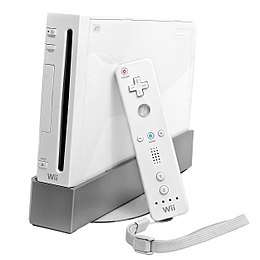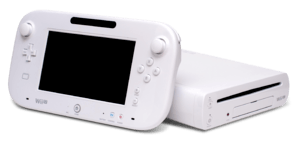Wii (video game series)
| Wii | |
|---|---|
 | |
| Genres |
Sports Party Exergaming Music |
| Developer(s) |
Nintendo EAD Nd Cube Ganbarion |
| Publisher(s) | Nintendo |
| Platforms |
Wii Wii U |
| Platform of origin | Wii |
| First release |
Wii Sports November 19, 2006 |
| Latest release |
Wii Sports Club July 25, 2014 |
The Wii game series is a series of exergaming simulation games for the Wii and Wii U video game consoles published by Nintendo. These games feature a common design theme, especially in their casual gameplay style and Mii integration. The series features control schemes that simulate real-life activities with various combinations of the Wii Remote, the Wii U GamePad, and the Wii Balance Board.
Wii series was conceived by Nintendo executive Shigeru Miyamoto to package and sell similar Wii Remote prototype games in a single package.[1]
Gameplay
The Wii uses motion sensors in the game controllers to allow gameplay that incorporates physical movements by the player to control action within the game. For example, in the Baseball game included in Wii Sports, the player holds the controller like a baseball bat and swings it in order to hit the ball in the on-screen game.[2]
Games
The Wii series has become one of the best-selling video game franchises, with each game in the Wii series selling millions of copies. Wii Sports in particular is regarded as the fourth best-selling video game of all time.[3] Wii Fit, within 18 months by June 2009, helped the health game genre generate collective revenues of $2 billion, most of which was grossed by Wii Fit's 18.22 million sales at the time.[4] The largest subset of the franchise is the Wii Sports sub-series.[5]
Wii Sports
| Game | Console | Release Date | Description | GameRankings | Metacritic | Sales |
|---|---|---|---|---|---|---|
| Wii Sports | Wii | The first game in the series and launch game for the Wii console. The game was sold bundled with the console in all regions except Japan and South Korea. Wii Sports is known for starting a new development direction for Nintendo involving simple gameplay, simple graphics, and motion control. It is one of the best-selling video game of all time. | 76.28%[6] | 76/100[7] | 82.85 million[8] | |
| Wii Sports Resort | Successor to Wii Sports. It is one of the first titles to require the Wii MotionPlus accessory, which was bundled with the game. Though the game was originally a standalone title, it was later bundled with the Wii console. | 82.65%[9] | 80/100[10] | 33.08 million[8] | ||
| Wii Sports Club | Wii U | Tennis & Bowling Golf
Retail |
A remake of the original Wii Sports game, it now requires the Wii MotionPlus accessory. Initially, it was only available on the Nintendo eShop with each sport needing to be bought separately. A retail release with all five sports has also been released.
It was about to be called Wii Sports U, but was changed to Wii Sports Club. |
68.69%[11] | 68/100[12] |
Wii Play
| Game | Console | Release Date | Description | GameRankings | Metacritic | Sales |
|---|---|---|---|---|---|---|
| Wii Play | Wii | The next game in the series was a launch game for the Wii in Japan. It features a compilation of nine minigames, such as Shooting Range or Table Tennis, that are used to teach the user how to use the Wii Remote. Wii Play was bundled with an extra Wii Remote and is one of the best selling video games of all time.[13] | 61.64%[14] | 58/100[15] | 28.02 million[8] | |
| Wii Play: Motion | This sequel to Wii Play is the most recently released game in the subseries for the Wii console. It includes twelve minigames, and it is bundled with the Wii Remote Plus, which is required to play. The minigames were created by various developers, including Good-Feel, Skip Ltd., and Arzest Corporation. | 61.89%[16] | 60/100[17] | 1.26 million[18] |
Wii Fit
| Game | Console | Release Date | Description | GameRankings | Metacritic | Sales |
|---|---|---|---|---|---|---|
| Wii Fit | Wii | The first game to use the Wii Balance Board peripheral, wherewith it was bundled. As a fitness-oriented game, it measures a user's weight, telling the user his or her health based on body mass index, and provides minigames for the user to exercise or to improve posture. It is currently the third-best-selling console game of all time of those not packaged with a console. | 81.18%[19] | 80/100[20] | 22.67 million[8] | |
| Wii Fit Plus | An enhanced version of Wii Fit. | 80.83%[21] | 80/100[22] | 21.13 million[8] | ||
| Wii Fit U | Wii U | The next entry in the Wii Fit subseries which was announced at E3 2012 as a title for the Wii U console. | 76.08%[23] | 72/100[24] |
Wii Party
| Game | Console | Release Date | Description | GameRankings | Metacritic | Sales |
|---|---|---|---|---|---|---|
| Wii Party | Wii | Players partake in various party games, similar to the Mario Party series.[25] It is the first game in the series in which Shigeru Miyamoto was not involved in development. | 70.44%[26] | 68/100[27] | 9.32 million[8] | |
| Wii Party U | Wii U | Developed by the same team behind the original Wii Party.[28] | 64.68%[29] | 65/100[30] | 1.35 million[31] |
Other titles
| Game | Console | Release Date | Description | GameRankings | Metacritic | Sales |
|---|---|---|---|---|---|---|
| Wii Chess | Wii WiiWare | A chess game playable in singleplayer or online. The game was released exclusively as WiiWare in Japan. | ||||
| Wii Music | Wii | Focused on using the Wii Remote and Nunchuk to simulate playing instruments. | 64.34%[32] | 63/100[33] | 2.65 million[34][35] |
Software
| Game | Console | Release Date | Description | GameRankings | Metacritic | Sales |
|---|---|---|---|---|---|---|
| Wii Street U | Wii U | |||||
| Wii U Panorama View | Wii U |
References
- ↑ Kohler, Chris (April 5, 2017). "Q&A: Design lessons learned from a decade at Nintendo's EAD". Gamasutra. UBM TechWeb. Retrieved April 6, 2017.
- ↑ Davis, Ryan. "Wii Sports Review". GameSpot. GameSpot. Retrieved 3 March 2013.
- ↑ Tom Ivan (May 8, 2009). "Wii Sports The Best Selling Game Ever?". Edge. Retrieved 2011-04-29.
- ↑ Kris Pigna (2009-06-28). "Health Games Generate $2 Billion in Worldwide Sales". 1UP.com. Archived from the original on 2012-07-28. Retrieved 2011-05-01.
- ↑ Kyle Orland (January 28, 2011). "Super Mario Galaxy 2 Sells 6.15M Worldwide, Wii Sports Series Passes 102M". Gamasutra. Retrieved 2011-04-29.
- ↑ "Wii Sports for Wii". GameRankings. Retrieved July 5, 2018.
- ↑ "Wii Sports for Wii Reviews". Metacritic. Retrieved 2018-04-03.
- 1 2 3 4 5 6 "Nintendo Top Selling Software Sales Units: Wii". Nintendo. 2012-03-31. Retrieved 2018-07-04.
- ↑ "Wii Sports Resort for Wii". GameRankings. Retrieved 2018-07-05.
- ↑ "Wii Sports Resort for Wii Reviews". Metacritic. Retrieved January 10, 2014.
- ↑ "Wii Sports Club for Wii U". GameRankings. Retrieved January 10, 2014.
- ↑ "Wii Sports Club for Wii U Reviews". Metacritic. Retrieved January 10, 2014.
- ↑ "Financial Results Briefing for the Six-Month Period ended December 2009" (PDF). Nintendo. October 31, 2009. p. 11. Retrieved January 29, 2010.
- ↑ "Wii Play for Wii". GameRankings. Retrieved January 10, 2014.
- ↑ "Wii Play for Wii Reviews". Metacritic. Retrieved January 10, 2014.
- ↑ "Wii Play: Motion for Wii". GameRankings. Retrieved January 10, 2014.
- ↑ "Wii Play: Motion for Wii Reviews". Metacritic. Retrieved January 10, 2014.
- ↑ "Financial Results Briefing for the Q3 Fiscal Year" (PDF). Nintendo. 2012-04-27. p. 6. Retrieved 2012-05-14.
- ↑ "Wii Fit for Wii". GameRankings. Retrieved January 10, 2014.
- ↑ "Wii Fit for Wii Reviews". Metacritic. Retrieved January 10, 2014.
- ↑ "Wii Fit Plus for Wii". GameRankings. Retrieved January 10, 2014.
- ↑ "Wii Fit Plus for Wii Reviews". Metacritic. Retrieved January 10, 2014.
- ↑ "Wii Fit U for Wii U". GameRankings. Retrieved January 10, 2014.
- ↑ "Wii Fit U for Wii U Reviews". Metacritic. Retrieved January 10, 2014.
- ↑ Harris, Craig (October 3, 2010). "Wii Party Review". p. 1. Retrieved December 6, 2010.
- ↑ "Wii Party for Wii". GameRankings. Retrieved January 10, 2014.
- ↑ "Wii Party for Wii Reviews". Metacritic. Retrieved January 10, 2014.
- ↑ "Wii U Party Will Get The Family Together This Summer". Nintendo Life.
- ↑ "Wii Party U for Wii U". GameRankings. Retrieved January 10, 2014.
- ↑ "Wii Party U for Wii U Reviews". Metacritic. Retrieved January 10, 2014.
- ↑ "IR Information : Sales Data - Top Selling Software Sales Units - Wii U Software". Nintendo.
- ↑ "Wii Music for Wii". GameRankings. Retrieved January 10, 2014.
- ↑ "Wii Music for Wii Reviews". Metacritic. Retrieved January 10, 2014.
- ↑ As of March 2009.
- ↑ "Financial Results Briefing for the Fiscal Year Ended March 2009: Supplementary Information" (PDF). Financial Results Briefing for the 69th Fiscal Term Ended March 2009. Nintendo. 2009-05-08. p. 6. Retrieved 2009-05-08.

